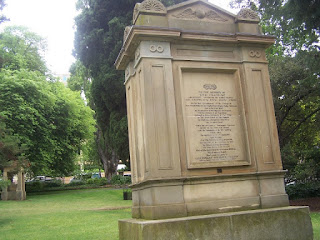When walking down Davey Street stop at the intersection with Salamanca Place where you will come to the entrance of St David's Park. The area where the park now stands has been in use since the early days of European settlement when it was used as the cemetery for Hobart Town.
St David's Park, as we know it today, was opened in 1926 and was designed by L J Liscombe. The park contains many monuments of historical interest.
One of the monuments was erected in memory of David Collins, Lieutenant Governor of the Colony, who was buried in the cemetery in March 1810. This monument was built in 1838.
In 1811 a small wooden church was built with the altar situated above the grave of David Collins. Shortly after the construction of the church it was blown down during a storm. The image below shows an artist's impression of the wooden church as it may have been. The image has been placed in the present setting of the gardens showing a possible location for the church.
Another prominent monument is the memorial to the First Fleeters and others from Norfolk Island who settled in Tasmania from 1807 and 1813. The Norfolk Island settlers who arrived from 1805 are also listed.
Burials were made in St David's Cemetery from 1804 until 1872. A main feature of the park is an arrangement of stone walls covered with the surviving plaques from burial sites in the cemetery. Many bodies are still buried in the park while some were removed to new cemeteries.
The Fellowship of the First Fleeters has also created a memorial to those buried in the cemetery who had arrived in New South Wales in 1788.
St David's Park is an essential place to visit for anyone interested in the history of Hobart Town.
For more information read the post about St David's Park in the blog, On the Convict Trail.








No comments:
Post a Comment